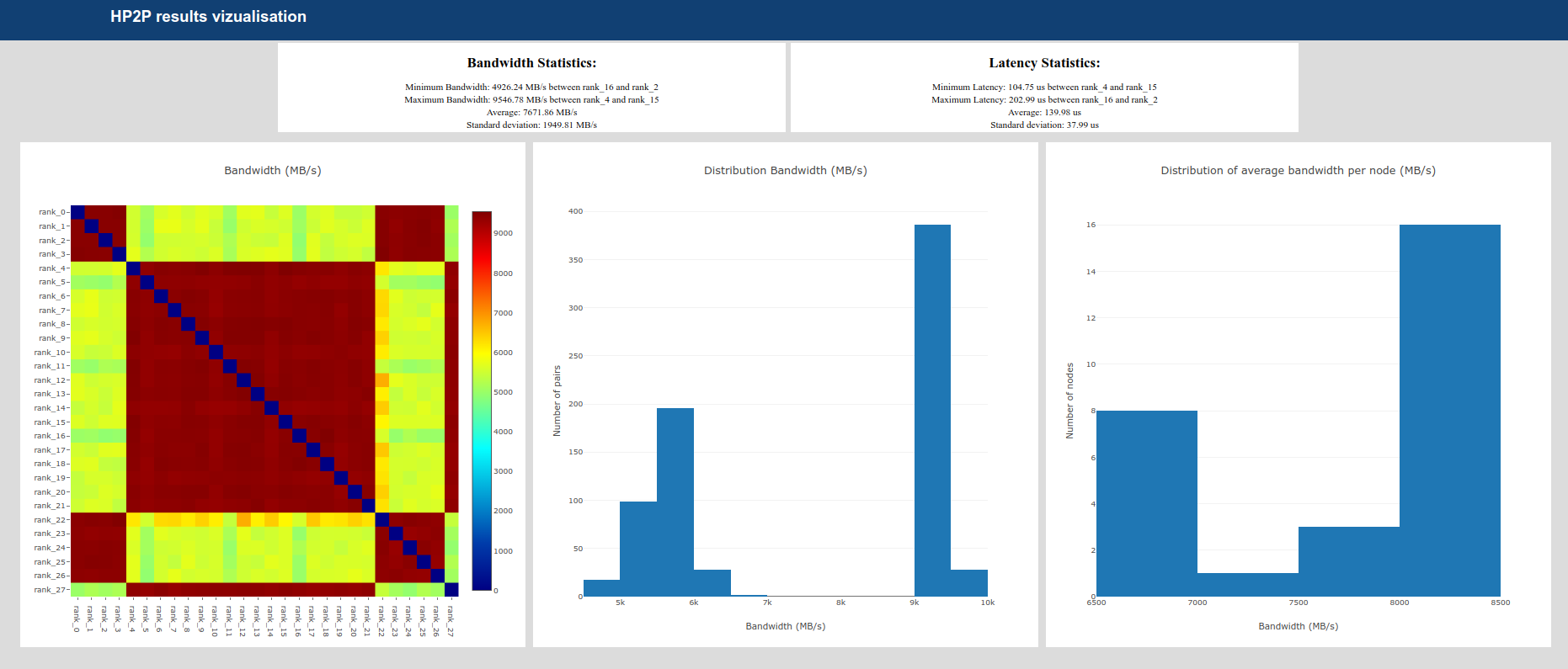HP2P (Heavy Peer To Peer) benchmark is a test which performs MPI Point-to-Point non-blocking communications between all MPI processes. Its goal is to measure the bandwidths and the latencies in a situation where the network is busy. This benchmark can help to detect network problems like congestions or problems with switches or links.
The benchmark generates an HTML output with interactive visualisation with Plotly.
The HTML output file can be processed to generate a static PNG file with command line (no Web browser needed).
New: HTML report can be generated instead of Python GUI for portability. The following link gives an example of a report.
Main program:
- C++ compiler
- MPI
HTML parser:
- Python 3
- plotly
- kaleido
$ ./configure --prefix=<path-to-install>
$ make
$ make install
The program hp2p.exe is generated.
$ hp2p.exe -h
Usage: ./hp2p.exe [-h] [-n nit] [-k freq] [-m nb_msg]
[-s msg_size] [-o output] [-a align] [-y]
[-p file] [-i conf_file]
[-f bin|html] [-M max_comm_time] [-X mult_time]
Options:
-i conf_file Configuration file
-n nit Number of iterations
-k freq Iterations between snapshot
-s msg_size Message size
-m nb_msg Number of msg per comm
-a align Alignment size for MPI buffer (default=8)
-t max_time Max duration
-c build Algorithm to build couple
(random = 0 (default), mirroring shift = 1)
-y anon 1 = hide hostname, 0 = write hostname (default)
-p jsfile Path to a plotly.min.js file to include into HTML
Use get_plotlyjs.py script if plotly is installed
in your Python distribution
-o output Output file
-f format Output format (binary format = bin, plotly
format = html) [default: html]
-M max_comm_time If set, print a warning each time a
communication pair is slower than
max_comm_time
-X mult_time If set, print a warning each time a
communication pair is slower than
mult_time * mean of previous
communication times
The program is written in MPI:
$ mpirun -n 32 ./hp2p.exe -n 1000 -s 1024 -m 10 -b 1 -o first_test -o output.html
This command will launch the benchmark on 32 MPI processes and will run 1000 iterations. An iteration consists on a draw of random couples of MPI processes and then a phase where 10 successive communications of 1024 bytes will be performed. The benchmark aims to test the network, so it is better to launch the benchmark with 1 MPI process per node. At the end of the execution, the output.html file wan be viewed with a web browser.
$ ./configure --enable-cuda --with-cuda=${CUDA_ROOT}
$ make
$ make install
hp2p should be launched with one MPI process for one GPU. If you have 4 GPUs on one node, you should launch 4 MPI processes on the node.
$ ./configure --enable-rocm --with-rocm=${ROCM_ROOT}
$ make
$ make install
hp2p should be launched with one MPI process for one GPU. If you have 4 GPUs on one node, you should launch 4 MPI processes on the node.
Signals can be sent to one of hp2p processes to make the program generate an output:
$ ./configure --enable-signal
$ make
$ make install
$ mpirun -n 32 ./hp2p.exe -n 1000 -s 1024 -m 10 -b 1 -o first_test -o output.html
$ kill -s SIGUSR1 <hp2p process PID> # make hp2p generate an output
$ kill -s SIGTERM <hp2p process PID> # make hp2p generate an output and exit
The benchmark generate a HTML file that can be displayed with a recent web browser supporting HTML5 standard.
A PNG file can be generated from the HTML file:
$ hp2p_html_parser.py png <output>.html
See the list of AUTHORS who participated in this project.
Laurent Nguyen - laurent.nguyen@cea.fr
Copyright 2010-2024 CEA/DAM/DIF
HP2P is distributed under the CeCILL-C. See the included files
Licence_CeCILL-C_V1-en.txt (English version) and
Licence_CeCILL-C_V1-fr.txt (French version) or visit
http://www.cecill.info for details.
The benchmark is similar to the FZ-Juelich linktest benchmark.
